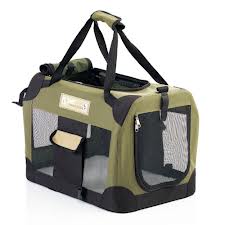If you have a cat, then I would most certainly recommend that you get a cat carrier. In my view, it isn't practical to take your pet to the vets without one, and although you could make use of a sturdy cardboard box, most cats are easily capable of demolishing a cardboard box quite quickly. Those handy cardboard pet carriers may be cheap but are only really suitable for a short trip home from the vets. There is a wide range of purpose made cat carriers on the market designed specifically for the purpose. These are often designed by people who are fully familiar with feline escapologists!
A robust new carrier should last for your cat’s lifetime. Some come complete with cushion and water bowl, although for long car journeys, an ordinary water bowl can be better when stopping for a break. When in the car you might prefer to secure the carrier by putting the seat belt through the handle and into the restraint so that if you should need to brake suddenly, it will not tip over.
Hard plastic carriers are robust and rigid which means they will stack for storage in the short term and you can take it apart for longer term storage. They are easy to keep clean as all they need in the event of an “accident” is a quick wipe over with a clean cloth or wet wipe, until you have chance to give it a thorough wash with a cat-safe disinfectant. The cushion, of course, just lifts out for washing. Alternatively, you can place a favourite cat blanket that is easily washable in the bottom of the cat carrier to keep your “puss” comfortable and dry. Plastic carriers are also unlikely to harbour fleas like softer carriers may. Even though your cat may be free of fleas, you cannot guarantee the other patients at the vets are so lucky.
Most carriers have front opening doors but some have an opening at the top as well - handy if you prefer to lift your cat out from above. Most cats don’t become attached to the carrier and will hide when they see it, probably because they associate it with visits to the vet or a cattery. However, some cats do like to snooze in them at home and some cat owners leave their carrier at the cattery as their pet prefers to sleep in it. Cats seem to like carriers which are mostly enclosed but they can still see out on all sides - they seem to appreciate this especially at the vets when there are dogs about. They can watch what is going on without feeling too exposed and vulnerable. In hot weather it will also offer some shading from the sun when the cat is on its travels.
It is always a good idea to get cats used to carriers as kittens and, if you can, use it for pleasant events from time to time to dispel negative associations, which is easier said than done. Encourage kittens early by offering food or treats in the cat carrier, or by throwing favourite toys into the back of the carrier.
When purchasing a cat carrier, consider the durability, weight, ability to clean, airline compliance (if you plan to travel), stability, size and ventilation. Cats generally don't want to get out of their carriers when they arrive at their new location and trying to get them out of a front only style carrier can be challenging. If the top is removable, this can make letting “puss” out a much easier process.
Soft carriers are comfortable and nice for short trips. They are generally not airline approved and offer less ventilation than the hard plastic designs but are softer and more comfortable. They can make cats feel more secure but are harder to clean if “accidents” occur. Some have a pull out washable liner which is ideal.
Cat carriers are an essential part of any disaster plan. Have carriers in an easy to locate area incase of a flood, fire etc., in or near your home. If possible, you should have one available for every pet in your household.


No comments:
Post a Comment